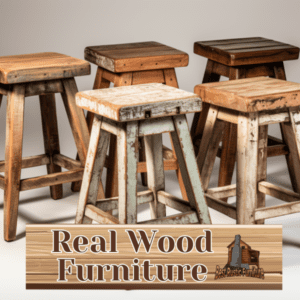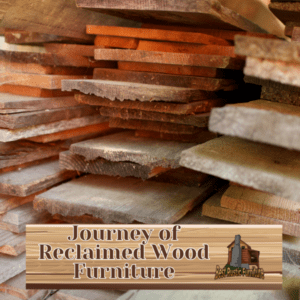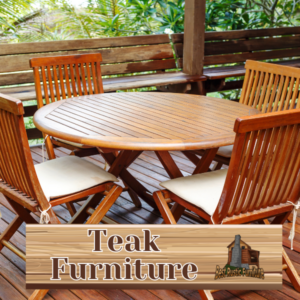
Has your wood furniture lost its luster due to sun exposure? Don’t worry, with some careful restoration, you can bring it back to life. Sun-faded wood furniture can present an unattractive appearance, but it’s a common problem that can be corrected. In this guide, we’ll help you restore the color and finish of your sun-damaged wood furniture, so it looks just like new again.
Key Takeaways:
- Continuous sun exposure can cause wood furniture to fade in color and finish.
- Assess the damage before starting the restoration process.
- Clean the surface thoroughly before proceeding with restoration.
- Sanding, patching, and restoring color are essential steps for repairing sun-faded wood furniture.
- Apply a protective finish to enhance appearance and protect the furniture in the future.
Assessing the Damage
If you have sun-faded wood furniture, it’s important to assess the damage before starting the restoration process. Surface area affected by sun damage can vary, so check for discoloration or fading on all parts of the furniture.
Look closely at the surface of the wood and identify the areas that require attention. Check for any cracks, chips, or rough patches that may have formed over time.
Tip: To get a better look at the condition of your sun-faded wood furniture, take a photo of it in natural light. This can help you identify any areas that need extra attention.
Section 3: Cleaning the Surface
Before starting the restoration process, it’s crucial to clean the surface of the sun-faded wood furniture thoroughly. Over time, dirt and stains can accumulate on the furniture, making the restoration process more challenging. Here are the recommended steps for cleaning sun-faded wood furniture:
- Prepare a cleaning solution by mixing warm water and mild soap in a bucket.
- Dip a soft cloth in the cleaning solution and wring it out.
- Gently scrub the surface of the furniture with the damp cloth, paying extra attention to the areas with stains or dirt.
- Rinse the cloth with clean water and wipe the surface again to remove any soap residue.
- Let the furniture dry completely before proceeding with the next steps.
It’s essential to avoid using abrasive cleaners or scrubbers, as they can damage the surface of the sun-faded wood furniture. Also, be careful not to use too much water, as it can seep into the wood and cause warping or cracking.
Expert Tip: For tough stains that don’t come off with soap and water, you can try using a specialized wood cleaner or wood bleach. Be sure to read the product instructions carefully and test it on a small, inconspicuous area before applying it to the entire piece of furniture.
Sanding and Patching: Restoring Your Sun-Faded Wood Furniture
Before you can restore the color of your sun-faded wood furniture, you need to sand down the sun-damaged areas. Sanding helps to smooth out any rough patches and prepares the surface for repairs. To do this, you’ll need to gather some fine-grit sandpaper or glasspaper, as well as some wood putty.
Assessing the Damage and Identifying Patches
Start by assessing the extent of the sun damage on your wood furniture. Inspect the surface for any signs of fading or discoloration, and identify the areas that require attention. Then, use the sandpaper to remove the damaged layers in a circular motion, taking care to apply even pressure. Sand until the surface is smooth and even, but be careful not to over-sand or you may damage the wood further.
Patching the Wood
After sanding, you may notice cracks or holes in the wood. Use wood putty to fill these areas, ensuring a seamless finish. Apply the putty with a putty knife, making sure to spread it evenly over the patch and feathering the edges to blend it in with the surrounding wood. Once the putty has dried, sand the surface again to smooth out any remaining rough patches.
The Importance of Fine-Grit and Glasspaper
When sanding your sun-damaged wood furniture, it’s essential to use fine-grit sandpaper or glasspaper. These types of sandpaper have a higher number of abrasive particles per square inch, making them ideal for smoothing out small scratches and imperfections in the wood. Coarse-grit sandpaper, on the other hand, can be too harsh and cause further damage to the wood.
Final Tips
When sanding and patching your sun-faded wood furniture, take your time and be patient. Rushing the process can lead to mistakes and further damage. Always sand in the direction of the grain, and use a tack cloth to remove any dust or debris before applying the stain and finish.
Restoring Color of Sun-Faded Wood Furniture
Once the surface is smooth and patched, it’s time to restore the color of your sun-faded furniture. Choosing the right wood stain is crucial for achieving the desired outcome. Consider the type of wood species you are working with since the color absorption rate will vary depending on the wood’s density and grain patterns.
Start by testing the stain on a small, inconspicuous area of the furniture to ensure you are happy with the color. Once you are ready to proceed, follow these steps:
- Clean the surface with a damp cloth and let it dry completely.
- Apply the wood stain evenly with a brush or cloth, following the direction of the wood grain.
- Let the stain sit for a few minutes, then wipe off the excess with a clean cloth.
- Allow the stain to dry completely according to the manufacturer’s instructions.
- Repeat the process if necessary, until you achieve the desired color.
Remember that the color of the wood stain will darken as it dries, so be patient and avoid applying too much at once. If you want a deeper color, you may need to repeat the process until you reach your desired shade.
Pro Tip: If you want to customize the color of your wood stain, you can mix different shades together to create a unique hue. Just be sure to test it on a small area first to ensure you are happy with the result.
Applying Finish to Sun-Faded Wood Furniture
After restoring the color of your sun-faded wood furniture, the next step is to apply a suitable finish for protection and enhanced appearance. There are several options to choose from, including:
| Finish Type | Description |
|---|---|
| Paint | A good option for furniture that requires a solid color finish. It provides excellent protection against UV damage and moisture, but may hide the natural wood grain. |
| Varnish | A transparent finish that enhances the natural grain and color of the wood. It provides excellent protection against UV damage, water, and scratches, but may require multiple coats. |
| Wax | A natural finish that provides a soft shine to the wood. It’s easy to apply and gives a natural feel, but it may not provide as much protection as other finishes and may require frequent reapplication. |
| Sealant | A clear finish that provides excellent protection against moisture and UV damage. It’s easy to apply and provides a natural feel, but it may not enhance the natural grain of wood as well as varnish. |
When applying finish to your wood furniture, follow the manufacturer’s instructions for best results. Apply in a well-ventilated area and use a brush or cloth to spread the finish evenly. Allow the first coat to dry completely before adding a second coat. Depending on the type of finish you choose, you may need to sand lightly between coats to ensure a smooth finish.
Overall, applying a finish to your sun-faded wood furniture is an important step in restoring its original beauty and protecting it from future damage. Choose the right type of finish for your furniture and follow the instructions carefully for best results.
Caring for Sun-Faded Wood Furniture
As you know, continuous exposure to sunlight can cause the color and finish of wooden furniture to fade. Therefore, proper care and maintenance are key to preventing further damage and preserving its original beauty. Below are some tips to help you care for your sun-faded wood furniture:
Protecting from Sun Exposure
To protect your wood furniture from further sun damage, avoid placing it in direct sunlight for extended periods. If this is unavoidable, consider using window film, blinds, or curtains to filter harmful UV rays. This will help maintain the natural color and finish of the wood. Additionally, you could use protective covers to further shield your furniture from the sun.
Maintenance is Key
Regular maintenance is essential to keeping your sun-faded wood furniture looking its best. Dust your furniture regularly with a soft cloth to prevent the buildup of dirt or grime. Use a furniture polish that is suitable for wood surfaces. Be careful with chemical cleaners, as they can strip the finish and damage the wood. If any spills or stains occur, clean them immediately with a damp cloth.
Natural Light and Heat
Wood furniture should not be placed in areas with extreme fluctuations in temperature or high humidity. This can cause warping, cracking or splitting of the wood. Additionally, exposure to natural light can cause bleaching of the wood surface over time. To prevent this, you can rearrange your furniture periodically or use curtains and shades.
Table: Cleaning and Maintenance Schedule for Wood Furniture
| Task | Frequency |
|---|---|
| Dust with a soft cloth | Weekly |
| Clean with a damp cloth and mild soap solution | Monthly |
| Polish with furniture polish | Quarterly |
| Inspect for damage or stains | Annually |
Tip: It’s always better to be cautious with wooden furniture. You could consider regular checkups by a professional or a furniture restoration specialist to keep your furniture in top condition.
Tips for Outdoor Furniture
Outdoor wood furniture is exposed to the sun, wind, moisture, and other elements, which can cause fading and damage over time. However, with the proper care and maintenance, you can keep your outdoor furniture looking beautiful for years to come. Here are some tips:
- Choose weather-resistant wood species such as teak, cedar, or redwood, which are naturally resistant to rot and decay.
- Apply protective coatings such as spar varnish to seal the wood and prevent moisture from penetrating.
- Regularly clean and maintain outdoor furniture, using a mild detergent and water. Avoid using harsh chemicals or abrasive cleaners that can damage the wood.
- Store outdoor furniture indoors or cover it during inclement weather to prevent exposure to the elements.
- Consider placing outdoor furniture in shaded areas or under an umbrella to reduce exposure to direct sunlight.
Comparison of Weather-Resistant Wood Species:
| Wood Species | Advantages | Disadvantages |
|---|---|---|
| Teak | Durable, naturally resistant to moisture, decay, and insects. Contains natural oils that protect the wood and provide a unique appearance. | Expensive. Can change color over time without treatment. |
| Cedar | Lightweight, naturally resistant to decay and insects. Contains natural oils that repel pests and protect the wood. Can be stained or painted. | Not as durable as teak. Requires regular maintenance to retain color and finish. |
| Redwood | Strong and durable, naturally resistant to decay. Contains natural oils that protect the wood and provide a unique appearance. Can be stained or painted. | Expensive. Not as weather-resistant as teak or cedar. Can fade over time without proper treatment. |
By following these tips and choosing the right wood species and protective coatings, you can keep your outdoor furniture looking beautiful and vibrant for many years.
Dealing with Sun-Faded Fabric
If the sun-faded wood furniture has fabric cushions or upholstery, don’t worry, you can still address the color fading. Follow these simple steps:
- Remove the cushions or upholstery from the furniture.
- Check the care label to determine the fabric type and any special washing instructions.
- If the fabric can be machine-washed, use a mild laundry detergent and wash on a gentle cycle with cold water. If the fabric cannot be machine-washed, use a fabric cleaner specifically formulated for that type of fabric.
- To restore the color, use a fabric dye that closely matches the original color. Follow the instructions on the dye product for best results.
- Let the fabric dry completely before reattaching it to the furniture.
If the color fading is extensive, you may consider reupholstering or replacing the fabric altogether. This option may be more expensive but can give your furniture a brand new look!
Tip: To prevent future sun damage to fabric upholstery, consider applying a UV-resistant spray or using slipcovers when the furniture is not in use.
Preventing Further Damage to Sun-Faded Wood Furniture
After putting effort into restoring sun-faded wood furniture, it’s important to prevent further damage from sun exposure. Here are some tips to protect your furniture and maintain its beauty:
Protective Measures
Utilize protective measures such as applying sunscreen or UV protection products to your skin while near the furniture. Apply protective coatings such as a sealant or varnish to wood surfaces to prevent sun damage, and use tinted windows or window film to filter out harmful UV rays.
Placement
Consider the placement of your furniture and avoid placing it in direct sunlight for extended periods. If possible, keep it in a shaded area or use curtains, blinds, or other protective measures to block the sun’s rays.
Cleaning and Maintenance
Regularly dust and polish your furniture to maintain its natural beauty. Avoid using harsh chemicals or cleaners that could strip away the protective coatings, and instead use a soft cloth and a mild soap solution to gently clean the surface.
Outdoor Furniture
Outdoor wood furniture is particularly susceptible to sun damage due to constant exposure to the elements. Choose weather-resistant wood species, or apply protective coatings such as spar varnish. Regularly clean and maintain outdoor furniture to prolong its lifespan.
Conclusion
Congratulations! You have successfully restored your sun-faded wood furniture to its former glory. By following the tips outlined in this article, you can now enjoy your furniture’s natural beauty for years to come. Remember, the key steps to restoration are assessing the damage, cleaning the surface, sanding and patching, restoring the color, and applying a protective finish.
Don’t forget to regularly maintain and care for your furniture by avoiding prolonged sun exposure and keeping it clean. For outdoor furniture, choose weather-resistant wood species or apply protective coatings to prevent further sun damage. And if your furniture has fabric cushions or upholstery, consider using fabric dye or reupholstering to address color fading.
Restoring sun-faded wood furniture is a satisfying process that can save you money and give your furniture a new lease on life. We hope these tips have been helpful in your restoration journey. Happy furniture fixing!
FAQ
How can I fix sun-faded wood furniture?
To fix sun-faded wood furniture, you can follow a step-by-step restoration process. This involves assessing the damage, cleaning the surface, sanding and patching, restoring the color, applying a protective finish, and taking preventive measures to avoid future sun damage.
How do I assess the damage on my wood furniture?
Before starting the restoration process, thoroughly inspect the surface of your wood furniture for any signs of fading or discoloration. Identify the areas that require attention and determine the extent of the sun damage.
What should I use to clean the surface of sun-faded wood furniture?
To clean the surface of sun-faded wood furniture, you can use a mixture of warm water and mild soap. Gently scrub the surface with a soft cloth to remove any dirt or stains that may have accumulated over time.
How do I sand and patch sun-damaged areas on wood furniture?
To sand and patch sun-damaged areas on wood furniture, use fine-grit sandpaper or glasspaper to smooth out rough patches. Fill any cracks or holes with wood putty to achieve a seamless finish before proceeding with the restoration process.
What can I use to restore the color of sun-faded furniture?
To restore the color of sun-faded furniture, choose a wood stain that closely matches the original color of the wood. Apply the stain evenly with a brush or cloth, following the instructions on the stain product for the best results.
How do I apply a finish to sun-faded wood furniture?
After the stain has dried, apply a suitable finish to protect the wood furniture and enhance its appearance. Options include paint, varnish, wax, or a sealant specifically designed for wood surfaces. Follow the manufacturer’s instructions for application and drying times.
How do I prevent further sun damage to wood furniture?
To prevent further sun damage to wood furniture, avoid placing it in direct sunlight for extended periods. Consider using window film, blinds, or curtains to filter harmful UV rays. Regularly dusting and polishing the furniture will also help maintain its natural beauty.
What can I do to protect outdoor wood furniture from sun damage?
Outdoor wood furniture is particularly susceptible to sun damage. Choose weather-resistant wood species or apply protective coatings such as spar varnish. Regularly clean and maintain outdoor furniture to prolong its lifespan.
How can I address sun-faded fabric on wood furniture?
If your sun-faded wood furniture has fabric cushions or upholstery, you can address the color fading. Use fabric dye specifically formulated for the material and follow the instructions for application. Alternatively, you may consider reupholstering or replacing the fabric altogether.
What can I do to prevent further sun damage to wood furniture?
To prevent further sun damage, apply protective coatings, use tinted windows or window film, and consider using sunscreen or UV protection products. These precautions will help maintain the original color and finish of your wood furniture.






